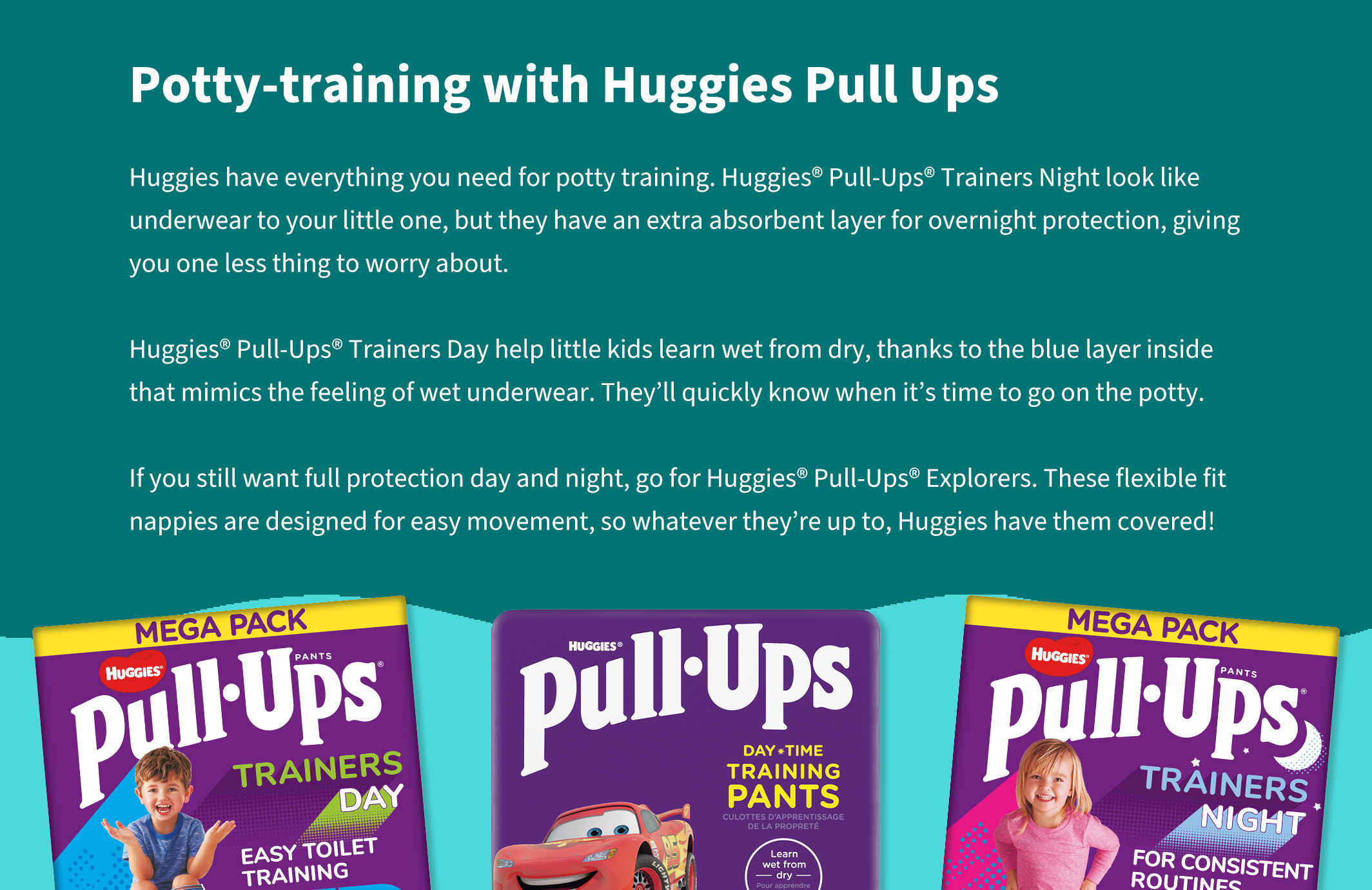Use arrow keys to navigate through the menu items. Use Tab key to navigate through the menu banners.
Potty Training Tips

Potty Training Tips
In partnership with Huggies
Thinking about tackling potty training? We’re here to support you as you embark on your little one’s latest milestone. There’s no set age to start, but most parents begin when they see signs of readiness – usually from around two years old.
Here’s what to look out for, plus potty training tips and tricks from the experts. Your little one will be in ‘big kid pants’ in no time!
Signs your child is ready
More dry nappies
If dry nappies are becoming the norm for longer periods of time, this is a sign that your little one’s bladder and bowel muscles have strengthened. The NHS advises that if the gap between wet nappies is at least one hour, it’s one of the signs they’re ready to potty train.
Keep an eye out for consistently dry nappies when you’d normally change a full one, or dry nappies after their daytime nap.
Talking about wetting or dirtying their nappy
Can your toddler say ‘wee’ and ‘poo’ and are they aware of what’s in their nappy? They may choose to talk about all things toilet related loudly when you’re surrounded by strangers on the bus, but view it as a positive step towards the next stage!
Put potty training on your agenda if they’ve started telling you when they’re doing their business, letting you know in advance they need to go, or trying to take their nappy off when it’s wet or dirty (lovely!).
Taking interest in the potty
When they happily sit on the potty, put their toys on the potty during playtime, or take interest when family members go to the toilet, it shows they have a good understanding of the potty’s purpose. Keep the excitement going as you prepare them and the household for potty training – trust us, it can be fun!
Potty training methods
1. The cold turkey approach: nappies off!
Goodbye nappies, hello underwear. This method dives straight into potty training, encouraging your child to go to the potty when the time comes instead of relying on a nappy. Start by showing them the potty and telling them to let you know when they need to go, asking them every 15-20 minutes or so.
If you see them start to have a little accident on the floor, pick them up and let them finish on the potty, always praising and reminding them that the potty is their place for wee and poo. Be as prepared as possible by putting newspaper or waterproof mats on the floor, having a mop nearby and reminding yourself to stay calm.
For peace of mind at night, choose Huggies® Pull-Ups® Trainers Night. And remember, you’ve got this.
2. The scheduled approach: potty training in intervals
If you prefer following a routine, this parent-led approach puts you in control. The method is all about setting a schedule that’s tailored to your child and putting them on the potty at regular intervals. This could be every two to three hours or before any activities, nap times and after mealtimes.
If you roughly know when your child does a poo each day, take them to the potty at these times to encourage them to do it there.
Still want your little one to wear pants as they go about their day? Grab Huggies® Pull-Ups® Trainers Day for an added layer of protection.
3. The pretend play approach: teddy on the potty
Children learn through play, so it’s time to integrate the potty into playtime! Encourage them to play with their teddy, then suggest they give it something to drink and sit it on the potty. Using the teddy, show them how to use the potty correctly, talking through every step of the process, from removing teddy’s nappy to washing its hands. Repeat from the beginning until your child fully understands.
Then, it’s their turn! Follow each step to a tee, starting with giving them a drink, all the way to praising them for each time they go on the potty.
If you’re still looking for full protection day and night, opt for Huggies® Pull-Ups® Explorers.
Expert tips and tricks
-
Prepare for potty training
Potty training should be something your child expects and feels excited about. ‘Read books about toilets, potties, poo and wee with your child,’ advises Georgina Durrant, author of 100 Ways Your Child Can Learn Through Play. ‘Chat about toilet matters openly, tell them when you’re going and count down the days together so they can look forward to starting.’ -
Go at their pace
‘Move at your child’s pace and if you feel like you’ve started too soon, there’s no harm in going back to nappies and resuming at a later date,’ says health visitor Helen Davies. In fact, Huggies found that 42% of parents say they’ve taken a break from potty training after starting. -
Have a reward system
Use a reward chart or box to spur them on, letting them pick a sticker or treat every time they use the potty correctly. ‘Take little rewards out with you to keep training consistent and tell your nursery or child carer about your reward system for consistency,’ suggests Amanda Jenner, author of Potty Training Magic. -
Keep them hydrated
‘Make sure your child is drinking six to eight drinks a day to encourage them to go on the potty regularly,’ says Alina Lynden, potty training expert at ERIC, The Children's Bowel & Bladder Charity. ‘Water is the best drink but milk in moderation and well-diluted squash is okay too.’
Help & Customer service
- Help Centre
- How to shop
- Product recalls
Payment Methodslist with 8 items
- Asda Group of Companies
- Modern Slavery Statement
- Electrical Waste Recycling
- Terms & Conditions
- Customer Review Policy
- Privacy Centre
- Cookie Settings
- Accessibility
© ASDA 2025
